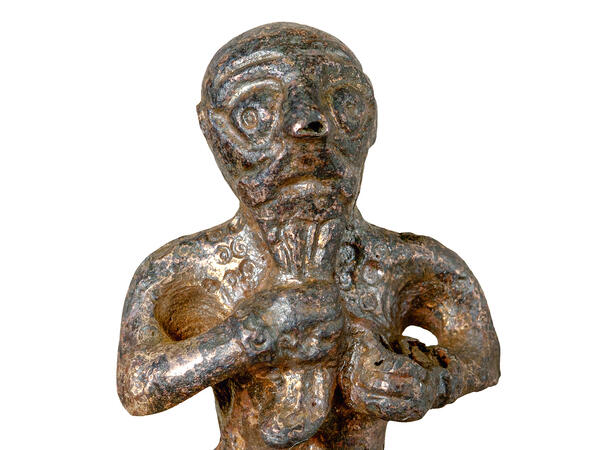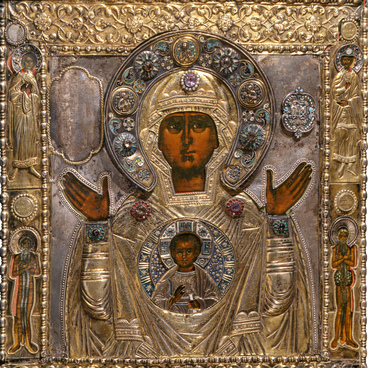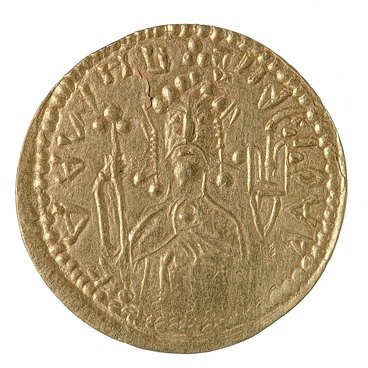The idol which is housed in the State Historical Museum is made of copper alloy. There are traces of gilding on its surface. The figurine depicts a man sitting with his legs crossed and his back straight. He clutches the end of his long beard with his right fist. It is likely, that he held an object in his left hand as well, which was lost, for example, a staff or a rod. The man is dressed in a caftan tied with knots on the sides. A geometric ornament, created by an unknown author, forms a pattern on the fabric and on the belt.
Some researchers suggest that this is a statuette of the Scandinavian god Thor — the god of thunder and lightning. It could serve as a “king-piece” in the Scandinavian board game hnefatafl, or “Kings’s table”. This version is confirmed by two sets of playing chips found in the burial mound among grave goods.
The Black Grave, where the figurine was found, is one of the largest ancient burial mounds, or kurgans, on the territory of the Chernihiv necropolis. Archaeologists discovered it in the early 1870s. The expedition was led by a scientist and professor of the University of Warsaw Dmitry Samokvasov.
The remains of several people were discovered in the mound: an adult man, a woman and a teenager. Two swords, a saber, a spear, a saddle with stirrups, arrowheads and fragments of chain mail were found next to the remains of the adult warrior. A copper-plated shield lay at his legs. Not far from the armor, they also found a ritual bronze brazier and a vessel with the remains of mutton bones. The remains of two saddled horses were located at the feet of the deceased.
The woman’s body was buried to the right of the man and the teenager. Several sickles, buckets and other iron vessels were placed next to her. In addition, a lot of jewelry pieces, gold and silver ingots, and belts were found in the burial mound. There was also a bronze vessel with dice — knucklebones. This game was an entertaining activity for teenagers. Therefore, scientists have suggested that one of the buried warriors was so young that he wore a partial helmet of a reduced size and played knucklebones.
Some researchers suggest that this is a statuette of the Scandinavian god Thor — the god of thunder and lightning. It could serve as a “king-piece” in the Scandinavian board game hnefatafl, or “Kings’s table”. This version is confirmed by two sets of playing chips found in the burial mound among grave goods.
The Black Grave, where the figurine was found, is one of the largest ancient burial mounds, or kurgans, on the territory of the Chernihiv necropolis. Archaeologists discovered it in the early 1870s. The expedition was led by a scientist and professor of the University of Warsaw Dmitry Samokvasov.
The remains of several people were discovered in the mound: an adult man, a woman and a teenager. Two swords, a saber, a spear, a saddle with stirrups, arrowheads and fragments of chain mail were found next to the remains of the adult warrior. A copper-plated shield lay at his legs. Not far from the armor, they also found a ritual bronze brazier and a vessel with the remains of mutton bones. The remains of two saddled horses were located at the feet of the deceased.
The woman’s body was buried to the right of the man and the teenager. Several sickles, buckets and other iron vessels were placed next to her. In addition, a lot of jewelry pieces, gold and silver ingots, and belts were found in the burial mound. There was also a bronze vessel with dice — knucklebones. This game was an entertaining activity for teenagers. Therefore, scientists have suggested that one of the buried warriors was so young that he wore a partial helmet of a reduced size and played knucklebones.



